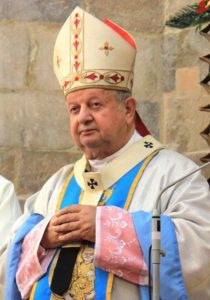The McCarrick Report Villains

The Report on the Holy See’s Institutional Knowledge and Decision-Making Related to Former Cardinal Theodore Edgar McCarrick (1930-2017) was issued by the Vatican’s Secretariat of State on November 10, 2020. The report was authored by U.S. attorney, Jeffrey Lena, who had previously represented the Vatican in several sex abuse cases. The 449-page document is the result of a two-year investigation, prompted by the public demand by Archbishop Carlo Vigano that Pope Francis resign for his alleged leniency to Cardinal McCarrick. Archbishop Vigano’s “testimony” was released on August 25, 2018 and splashed all over ultra-conservative Catholic media outlets. Gossipy and salacious, he pointed the finger at Pope Francis as the chief villain. Since then, the Vatican had been under heavy pressure to provide an explanation for Cardinal McCarrick’s rise, and his continued influence within the Church after rumors and accusations of sexual activity circulated for several decades.
Before his downfall, Cardinal McCarrick was a star among the U.S. Catholic hierarchy, both for his fund-raising prowess and his sophistication about American and global affairs. He brought the Vatican millions of dollars from the U.S. for papal charities.
Who are the main villains in The McCarrick Report?
#1 – Cardinal Theodore McCarrick. A man who used his position, influence, and financial gifts to manipulate or coerce seminarians and altar servers to have sex with him; and protect him from any career consequences. Many of his victims were children of family friends. All of the seminarians depended on his patronage to be ordained.
#2 – Pope John Paul II (1979-2005) – Pope John Paul II turned a blind eye to clerical sexual activity. His main concerns were freeing Poland from communism, keeping communism out of Latin American, and stamping out North American and European reformers and dissenters. His courtiers had free rein, especially after the mid-1990s when he began to suffer from Parkinson’s Disease, and became increasingly incapacitated mentally and physically. His hubris and handlers kept him propped up in Peter’s Throne so the good times could continue to roll. He ignored numerous complains about McCarrick, and continued to promote him from Bishop of Metuchen, NJ (1981), to Archbishop of Newark, NJ (1986), Archbishop of Washington, DC (2000), and finally named McCarrick a cardinal (2001). The best article I ever read about Pope John Paul II’s culpability in the Church’s sex abuse holocaust is Maureen Dowd’s A Saint, He Ain’t. Poland’s bishops lobbied hard for John Paul II’s early beatification and canonization but were rebuffed in 2019 when they petitioned the Vatican and fellow prelates worldwide to have him elevated still further as a Doctor of the Church and patron saint of Europe.
#3 – Cardinal Stanislaw Dziwisz. The McCarrick Report contains 45 references to Dziwisz, who first met McCarrick while visiting New York with the then, Cardinal Karol Wojtyla in 1976. When Karol Wojtyla became Pope John Paul II in 1978, Dziwisz served as his personal secretary for the Polish pontiff’s entire 27-year reign. Cardinal Dziwisz is accused of covering up sexual abuse in exchange for money. One of McCarrick’s victims, James Grein, said he once accompanied McCarrick on a trip to the Vatican with a briefcase containing envelopes full of money. The envelope addressed to Dziwisz held $10,000. 
The role of the former papal secretary in stifling sex abuse claims and protecting clerical abusers as favors or for money has come under recent scrutiny in Poland. A 90-minute documentary, “Don Stanislao” was recently shown on TVN24 in Poland. The film aired a long list of accusations about Dziwisz, from covering up for his friends in the seminary to the his role in protecting the late Father Marcial Maciel, the disgraced founder of the Legionaries of Christ, and former Cardinal McCarrick. The documentary also detailed how as archbishop of Krakow he ignored complaints against subsequently convicted local priests.
#4 – Pope Emeritus Benedict XVI – Pope Benedict asked Cardinal McCarrick to step down as archbishop of Washington, DC in 2006. Since he was 76, a year past the age of retirement, the request wasn’t extraordinary. “Over the next two years, Holy See officials wrestled with how to address issues regarding Cardinal McCarrick,” the report’s summary states. “Ultimately, the path of a canonical process to resolve factual issues and possibly prescribe canonical penalties was not taken,” the summary concludes. “Instead, the decision was made to appeal to McCarrick’s conscience and ecclesial spirit by indicating to him that he should maintain a lower profile and minimize travel for the good of the Church.” That didn’t happen; McCarrick continued his global lifestyle and high visibility.
Pope Benedict did and said nothing. Benedict also gave himself the excuse that McCarrick was already retired in not initiating formal disciplinary proceedings. “God’s Rottweiler” as the head of the Congregation for the Doctrine of the Faith (1981-2005) silenced and censored numerous theologians, bishops, priests and religious during his tenure. He decried secularization, liberation theology, feminism, homosexuality, religious pluralism, and bioethics. He gave clerical sex abuse and rape a pass.
#5 – Four New Jersey Bishops. These men vetted Archbishop of Newark McCarrick for the prestigious Washington, DC appointment—Bishop Emeritus Edward Hughes, Metuchen; Bishop John M. Smith, Trenton; Bishop James McHugh, Camden; and Bishop Vincent DePaul Breen, Metuchen. Of the four, only Bishop Edward Hughes advised that it would be “unwise to consider the Archbishop for any promotion or additional honor.” Even so, Bishop Hughes did not pass on reports from seminarians and priests who told him they had been abused by McCarrick. Both James McHugh of Camden and John Smith of Trenton witnessed McCarrick groping a seminarian at a dinner party but never reported it. 
All the New Jersey bishops confirmed the rumor that McCarrick persuaded seminarians to share his bed at his New Jersey Shore house. The Vatican report does not explain by these bishops would not regard sleeping with young men—at minimum–as a serious impropriety and lack of judgement. Nor does it indicate why it didn’t raise a red flag for sexual activity for Vatican officials. The report also included an allegation by an unnamed Metuchen priest who accused McCarrick of having sex with a third priest in June 1987. The accuser was not originally believed since he “had previously abused two teenage boys.”
As expected, The McCarrick Report has plenty of dirt to throw on the legacy of Pope Saint John Paul II: he didn’t bother to investigate sex crimes. That way, he never had sufficient evidence requiring him to act. Because he chose to look the other way, thousands of children, teenagers, seminarians, and vulnerable adults were victimized by clerical predators. The failure of his moral leadership deeply wounded the Catholic Church and many people of faith.
The Report highlights repeated failures in the processing of vetting bishops, a process that often seems more focused on personal connections and ensuring unquestioned adherence to doctrine rather than raising red flags on inappropriate or criminal behavior.
The system in place where archbishops are expected to police abuse by bishops is totally inadequate.
Finally, it shows how certain Vatican prelates—Cardinal Dziwisz and Cardinal Sodano chief among them—were happy to let crime and sin slide if they were paid.
